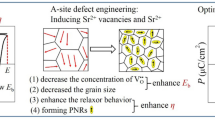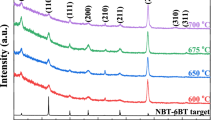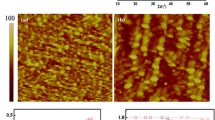Abstract
Considering the full utilization of energy and pursuing thin-film capacitors with high energy-storage density, the grain size engineering is used to adjust domain size, in order to enhance the energy-storage efficiency and energy-storage density of thin-film capacitors. Therefore, in this work, lead-free Bi0.5Na0.5TiO3 (BNT) films with designed grain size were grown on Nb-doped SrTiO3 (Nb:STO) (001) single-crystalline substrates by modulating the mineralizer concentrations via hydrothermal synthesis. The nature of epitaxial growth near the single-crystalline substrates was proved by transmission electron microscopy (TEM). In addition, the phenomenon of the decrease of grain size and the increase of [100] in-plane orientation with the decline of mineralizer concentrations were clarified by grazing-angle incidence X-ray diffraction (GIXRD) and field emission scanning electron microscope (FESEM). By reducing the grain size, an ultrahigh energy-storage efficiency (η) of 75.56% and superior the recoverable energy-storage density (Wrec) of 16.47 J/cm3 were acquired in pure Bi0.5Na0.5TiO3 films. Furthermore, the fine-grained film exhibits weak dependence on the frequency and has excellent anti-fatigue property. Therefore, hydrothermal synthesis is an efficient, inexpensive, and easy method, which is the most promising way to adjust grain size and energy storage of the film capacitor.

By decreasing the concentration of mineralizer, the thinner film with a smaller grain size can be obtained, which greatly improves the Pr and applied electric field of the BNT film. Hence, an ultrahigh η of 75.56% and superior Wrec of 16.47 J/cm3 were acquired in pure BNT film.
Highlights
-
Various grain size of BNT films are grown on STO by hydrothermal synthesis.
-
The growth mechanism of BNT films with different grain size is discussed in detail.
-
The energy-storage performance of BNT films is enhanced by decreasing grain size.
-
A superior energy-storage efficiency of 75.56% is acquired in pure BNT film.









Similar content being viewed by others

References
Eom C, Trolier-McKinstry S (2012) Thin-film piezoelectric MEMS. Mrs Bull 37:1007–1017
Jeon YB, Sood R, Jeong JH, Kim SG (2005) MEMS power generator with transverse mode thin film PZT. Sens Actuators A Phys 122:16–22
Khan A, Abas Z, Soo Kim H, Oh I (2016) Piezoelectric thin films: an integrated review of transducers and energy harvesting. Smart Mater Struct 25:053002
Yang L, Kong X, Li F, Hao H, Cheng Z, Liu H, Li J, Zhang S (2019) Perovskite lead-free dielectrics for energy storage applications. Prog Mater Sci 102:72–108
Luo H, Roscow J, Zhou X, Chen S, Han X, Zhou K, Zhang D, Bowen CR (2017) Ultra-high discharged energy density capacitor using high aspect ratio Na0.5Bi0.5TiO3 nanofibers. J Mater Chem A 5:7091–7102
Li F, Zhou M, Zhai J, Shen B, Zeng H (2018) Novel barium titanate based ferroelectric relaxor ceramics with superior charge-discharge performance. J Eur Ceram Soc 38:4646–4652
Yan F, Zhou X, He X, Bai H, Wu S, Shen B, Zhai J (2020) Superior energy storage properties and excellent stability achieved in environment-friendly ferroelectrics via composition design strategy. Nano Energy 75:105012
Zhu X, Shi P, Lou X, Gao Y, Guo X, Sun H, Liu Q, Ren Z (2020) Remarkably enhanced energy storage properties of lead-free Ba0.53Sr0.47TiO3 thin films capacitors by optimizing bottom electrode thickness. J Eur Ceram Soc 40:5475–5482
Wang Y, Wu H, Qin X, Yao K, Pennycook SJ, Tay FEH (2019) Outstanding piezoelectric performance in lead-free 0.95(K,Na)(Sb,Nb)O3-0.05(Bi,Na,K)ZrO3 thick films with oriented nanophase coexistence. Adv Electron Mater 5:1800691
Yin J, Zhang Y, Lv X, Wu J (2018) Ultrahigh energy-storage potential under low electric field in bismuth sodium titanate-based perovskite ferroelectrics. Journal of Materials Chemistry A 6:9823–9832
Xu Q, Chen X, Chen W, Chen S, Kim B, Lee J (2005) Synthesis, ferroelectric and piezoelectric properties of some (Na0.5Bi0.5)TiO3 system compositions. Mater Lett 59:2437–2441
Lee H, Sun W, Luo J, Zhou Z, Li J (2018) Sol-gel processing and nanoscale characterization of (Bi0.5Na0.5)TiO3-SrTiO3 lead-free piezoelectric thin films. Ceram Int 44:4114–4120
Ding J, Pan Z, Chen P, Hu D, Yang F, Li P, Liu J, Zhai J (2020) Enhanced energy storage capability of (1-x)Na0.5Bi0.5TiO3-xSr0.7Bi0.2TiO3 free-lead relaxor ferroelectric thin films. Ceram Int 46:14816–14821
Yang C, Lv P, Qian J, Han Y, Ouyang J, Lin X, Huang S, Cheng Z (2019) Fatigue-free and bending-endurable flexible Mn-doped Na0.5Bi0.5TiO3-BaTiO3-BiFeO3 film capacitor with an ultrahigh energy storage performance. Adv Energy Mater 9:1803949
Cao W, Randall CA (1996) Grain size and domain size relations in bulk ceramic ferroelectric materials. J Phys Chem Solids 57:1499–1505
Hoffmann MJ, Hammer M, Endriss A, Lupascu DC (2001) Correlation between microstructure, strain behavior, and acoustic emission of soft PZT ceramics. Acta Mater 49:1301–1310
Yan X, Zheng M, He Y, Zhu M, Hou Y (2020) Origin of superior dielectric and piezoelectric properties in 0.4Ba(Zr0.2Ti0.8)O3-0.6(Ba0.7Ca0.3)TiO3 at intermediate grain sizes. J Eur Ceram Soc 40:3936–3945
Zhu C, Cai Z, Guo L, Li L, Wang X (2021) Grain size engineered high-performance nanograined BaTiO3-based ceramics: Experimental and numerical prediction. J Am Ceram Soc 104:273–283
Ghasemian MB, Lin Q, Adabifiroozjaei E, Wang F, Chu D, Wang D (2017) Morphology control and large piezoresponse of hydrothermally synthesized lead-free piezoelectric (Bi0.5Na0.5)TiO3 nanofibres. Rsc Adv 7:15020–15026
Lu R, Yuan J, Shi H, Li B, Wang W, Wang D, Cao M (2013) Morphology-controlled synthesis and growth mechanism of lead-free bismuth sodium titanate nanostructures via the hydrothermal route. Crystengcomm 15:3984–3991
Wang Y, Xu G, Yang L, Ren Z, Wei X, Weng W, Du P, Shen G, Han G (2009) Hydrothermal synthesis and characterization of Na0.5Bi0.5TiO3 microcubes. Ceram Int 35:1657–1659
Zhou X, Jiang C, Chen C, Luo H, Zhou K, Zhang D (2016) Morphology control and piezoelectric response of Na0.5Bi0.5TiO3 synthesized via a hydrothermal method. Crystengcomm 18:1302–1310
Liu Y, Lu Y, Dai S (2009) Hydrothermal synthesis of monosized Bi0.5Na0.5TiO3 spherical particles under low alkaline solution concentration. J Alloy Compd 484:801–805
Peng B, Zhang Q, Li X, Sun T, Fan H, Ke S, Ye M, Wang Y, Lu W, Niu H, Scott JF, Zeng X, Huang H (2015) Giant electric energy density in epitaxial lead-free thin films with coexistence of ferroelectrics and antiferroelectrics. Adv Electron Mater 1:1500052
Thompson CV (1985) Secondary grain growth in thin films of semiconductors: theoretical aspects. J Appl Phys 58:763–772
Zhang H, Zhu M, Hou Y, Wang R, Yan H, Liu L (2016) Structural modulation of Na0.5Bi0.5TiO3 in hydrothermal synthesis. Int J Appl Ceram Tec 13:569–578
Jin L, Li F, Zhang S (2014) Decoding the fingerprint of ferroelectric loops: comprehension of the material properties and structures. J Am Ceram Soc 97:1–27
Zhao Z, Buscaglia V, Viviani M, Buscaglia MT, Mitoseriu L, Testino A, Nygren M, Johnsson M, Nanni P (2004) Grain-size effects on the ferroelectric behavior of dense nanocrystalline BaTiO3 ceramics. Phys Rev B 70:024107
Arlt G (1990) Twinning in ferroelectric and ferroelastic ceramics - stress relief. J Mater Sci 25:2655–2666
Wu J, Kang G, Liu H, Wang J (2009) Ferromagnetic, ferroelectric, and fatigue behavior of (111)-oriented BiFeO3/(Bi1/2Na1/2)TiO3 lead-free bilayered thin films. Appl Phys Lett 94:172906
Tang X, Wang J, Wang X, Chan HL (2004) Preparation and electrical properties of highly (111)-oriented (Na0.5Bi0.5)TiO3 thin films by a sol-gel process. Chem Mater 16:5293–5296
Wang J, Sun N, Li Y, Zhang Q, Hao X, Chou X (2017) Effects of Mn doping on dielectric properties and energy-storage performance of Na0.5Bi0.5TiO3 thick films. Ceram Int 43:7804–7809
Dargham SA, Ponchel F, Abboud N, Soueidan M, Ferri A, Desfeux R, Assaad J, Remiens D, Zaouk D (2018) Synthesis and electrical properties of lead-free piezoelectric Bi0.5Na0.5TiO3 thin films prepared by Sol-Gel method. J Eur Ceram Soc 38:1450–1455
Sui H, Yang C, Geng F, Feng C (2015) Effects of Zr doping content on microstructure, ferroelectric and dielectric properties of Na0.5Bi0.5TiO3 thin film. Mater Lett 139:284–287
Cheng Z, Zhao Z (2018) Ink-jet printed BNT thin films with improved ferroelectric properties via annealing in wet air. Ceram Int 44:10700–10707
Tunkasiri T, Rujijanagul G (1996) Dielectric strength of fine grained barium titanate ceramics. J Mater Sci Lett 15:1767–1769
Wu S, Song B, Li P, Chen P, Shen B, Zhai J (2019) Reduced leakage current and enhanced piezoelectricity of BNT-BT-BMO thin films. J Am Ceram Soc 103:1219–1229
Acknowledgements
This work was supported by the Priority Academic Program Development (PAPD) of Jiangsu Higher Education Institutions.
Author information
Authors and Affiliations
Corresponding authors
Ethics declarations
Conflict of interest
The authors declare no competing interests.
Additional information
Publisher’s note Springer Nature remains neutral with regard to jurisdictional claims in published maps and institutional affiliations.
Rights and permissions
About this article
Cite this article
Chen, F., Qian, H., Sun, X. et al. Grain size engineering and growth mechanism in hydrothermal synthesis of Bi0.5Na0.5TiO3 thin films on Nb-doped SrTiO3 substrates. J Sol-Gel Sci Technol 99, 366–375 (2021). https://doi.org/10.1007/s10971-021-05586-y
Received:
Accepted:
Published:
Issue Date:
DOI: https://doi.org/10.1007/s10971-021-05586-y



